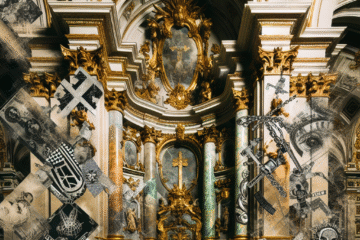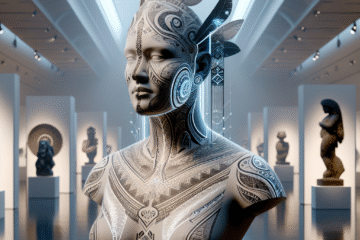
Image title: Hermann von Wedigh III (died 1560)
Medium: Oil and gold on oak
Date: 1532
Source:
The Met Collection
“
One that desires to excel should endeavor in those things that are in themselves most excellent.
”
— Epictetus
“The Frame Is a Lie”: Meta-Artworks That Refuse to Contain Themselves
Introduction: The Politics of the Perimeter
What does it mean to “frame” a work of art? At its surface, the answer seems simple — a frame provides a boundary, a decorative edge, a vessel of containment. But delve deeper and the frame becomes something philosophically and culturally charged: it determines not just what is seen, but how it’s understood. Increasingly throughout art history, especially in the modern and contemporary eras, artists have looked suspiciously at the frame, challenging its authority, questioning its neutrality, and even rejecting it outright. From Renaissance illusions to postmodern provocations, the frame — both literal and metaphorical — has been under assault. This article explores how artists across eras have defied the frame, transforming it from a passive boundary into an active battleground for meaning, institutional critique, and aesthetic liberation.
Chapter 1: Illusions of Continuity – The Renaissance and Baroque Disruptions
Even as far back as the Renaissance, artists were already beginning to destabilize the perceived neutrality of the frame. Trompe-l’œil techniques, popularized in the Baroque period, used optical illusions to create images that “escaped” their confines. An architectural frame might appear to be broken, as with Antonio de Pereda’s works or the ceiling frescoes of Andrea Pozzo, where St. Ignatius soars heavenward, seemingly tearing through the physical architecture of the church. These works played with the viewer’s perception, pointing toward the idea that meaning could transcend its prescribed limits — both physically and ideologically.
During this period, the frame also served a theological and political function. By creating visual illusions of transcendence, artists subtly implied that divine truth and royal authority could not be confined — signals that perhaps foreshadowed later, more critical deconstructions of institutional control.
Chapter 2: Romanticism and The Disintegration of Boundaries
Fast forward to the 18th and 19th centuries, and artists under the Romantic and later Symbolist umbrellas began to experiment with the unity of subject and surface. William Blake, for instance, produced “illuminated books,” in which image and text merged inseparably, defying the traditional separation between verbal and visual art. For Blake, this was not merely aesthetic innovation but a philosophical stance: the containment of spiritual truth within rational or institutional frameworks (such as the academy or organized religion) was a lie.
Gustave Moreau and Odilon Redon extended these ideas by saturating their canvases with dreamlike forms and cosmic longings, often filling edges and margins with dense symbolisms that spilled over the pictorial border. These were paintings that deliberately defied closure — conceptually and even spatially. The viewer was meant to feel disoriented, awe-inspired, and uncontained.
Chapter 3: Early Modernism – Shattering the Frame from Within
The 20th century witnessed an explicit confrontation with the frame as Modernism unfolded. The Cubists, particularly Georges Braque and Pablo Picasso, fragmented pictorial space, rendering any notion of a unified perspective meaningless. Futurism and Constructivism further attacked the stability of the frame by incorporating time, movement, and architecture into their visual language.
Perhaps no moment was more emblematic than Marcel Duchamp’s readymades, especially “Fountain” (1917). Here, the frame of the gallery — the institutional frame — was the target. Duchamp exposed the power structures that decided what was and was not art. By placing a urinal in a gallery, he not only questioned aesthetics but shattered the supposed sanctity of the art container itself—the museum, the white cube, the cultural elite.
Chapter 4: Postmodern Flux – Breaking the Frame Across Media
In the wake of World War II, artists began to view the frame as complicit in systems of control — capitalist, patriarchal, colonial. The 1960s and 70s birthed a wave of conceptual and performance art that sought to obliterate containment entirely. Carolee Schneemann’s “Interior Scroll” (1975), where she extracted a scroll from her vagina while reading from it, challenged not only the frame of the canvas but the very idea of art as a separate, observable object.
Similarly, land artists like Robert Smithson created site-specific works such as “Spiral Jetty” (1970) that escaped the reach of the gallery altogether. These works could not be bought, framed, or even fully experienced in person. The act of refusal — rejection of commodification, centralization, and often, permanence — redefined what an artwork could be while mocking the attempt to frame it.
Chapter 5: Digital Dissolution and the Frame as Algorithm
Today, with the rise of digital art and virtual exhibitions, the concept of the frame has transformed once more—less a wooden rectangle, more a digital screen or algorithmic interface. Net art and NFT practices explode the temporal and spatial boundaries of traditional art. In Rafael Rozendaal’s web-based pieces, the viewer experiences the artwork as a living digital environment, hosted online and shifting with time, participation, and code.
Moreover, algorithms now actively curate our visual cultures. Instagram frames your feed; algorithms frame what you see. In reaction, many media artists like Hito Steyerl produce works that address the violence of this digital framing. Her pieces question not just what is inside the frame, but who controls it and for what purpose.
Conclusion: Toward an Un-Framed Future
The history of frames — and their defiance — mirrors broader shifts in cultural, philosophical, and technological paradigms. As artists reject frames, they signal resistance to inherited norms, to capitalist commodification, and to passive spectatorship. The frame may be a lie, but in its deconstruction, lies an invitation: to see beyond boundaries, to question authority, and to encounter art — and the world — uncontained.

Image description:
File:Fattori – L’agguato unframed, Lot 36.jpg
License:
Public domain
Source:
Wikimedia Commons


